The tagline, “Tranquility in Green,” is evocative of the coolness of the arrangements in this post. Cool calmness is an apt description of these designs. Ichiyo instructor, Sylvia Webb, presented a demonstration and workshop using only leaves, not a bloom to be seen. You can view the unique features and components of her arrangements here.
Among the many forms of Ikebana, there is one in which we use all one material. It can be all one type of flower with its leaves, all one type of leaf, or various types of leaves. A dynamic simplicity is the goal; “less is more.”*
_______________________________________________________________________________________
Among the many forms of Ikebana, there is one in which we use all one material. It can be all one type of flower with its leaves, all one type of leaf, or various types of leaves. A dynamic simplicity is the goal; “less is more.”*
_______________________________________________________________________________________
* We use the phrase in every discipline today, so I decided to determine its origin. The Phrase Finder site provided the answer. http://www.phrases.org.uk/meanings/226400.html
This airy arrangement gives the illusion of stars floating in space. A simple form of two materials, Dracaena and an asparagus-like fern. The unique freestyle white container seems to blend into the white surface.
__________________________________________________________________________________
__________________________________________________________________________________
Below is a refreshing arrangement of three types of leaves in an antique Japanese basket. The upright, ascending line is a manipulated, curled Ti leaf. Hostas and a trimmed philodendron leaf complete the design and provide balance to the strong upright line. Even the basket handle contributes interest here.
| Leaves abound, even at the green grocer and farmer’s market. Napa cabbage leaves form the base of this arrangement with one yucca leaf, with remnants of a spent bloom, serving as the dominant line material. Three shades of green in a simple bowl are so tranquil. NB: Because this blog is global, this link is added here. The yucca plant is the New Mexico state flower. It grows wild, and is used in xeric landscaping throughout the Southwestern United States. http://www.netstate.com/states/symb/flowers/nm_yucca_flower.htm |
This is a compound arrangement, yet simple with one type of material, leaves. Even with the two containers, there are three main components, the braided Ficus, the naturally scalloped Fatsia, and a small Pothos leaf, assisted only by a small braided Dracaena marginata. Texture and gloss make the two matte black containers more compelling. The design possibilities with a pair of containers are practically endless.
Sylvia has used three large leaves from different plants: a bunch of Kale, Split-leaf Philodendron, and a hearty Hosta leaf. These large leaves are most appropriate for the strong, dark container. An impressive container such as this just begs for magnificent materials. I’d say this is the pièce de résistance.
_________________________________________________________________________________________
As a workshop participant, I attempted to employ the techniques and aesthetics from the demonstration in my arrangement. Using asparagus fern and Boston fern for line material, I’ve anchored the arrangement with a large variegated Fatsia and a solid Fatsia leaf. The three components, heaven, earth and humanity, are present here: notice the three different heights and the three types of leaves. (I just can’t resist placing my piece of petrified wood alongside most any arrangement. It just speaks to me.)
As a workshop participant, I attempted to employ the techniques and aesthetics from the demonstration in my arrangement. Using asparagus fern and Boston fern for line material, I’ve anchored the arrangement with a large variegated Fatsia and a solid Fatsia leaf. The three components, heaven, earth and humanity, are present here: notice the three different heights and the three types of leaves. (I just can’t resist placing my piece of petrified wood alongside most any arrangement. It just speaks to me.)
Finally, in view of the leaf study, I am sharing a work from five years ago. This commissioned leaf design needed to last three weeks with only added water every three or four days. Much to my delight, it lasted nearly a month.
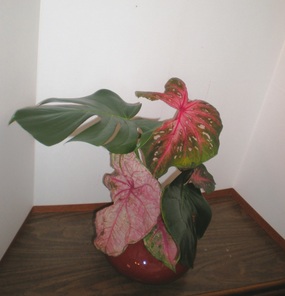 Leaf Study in Red and Green
Leaf Study in Red and Green The composition is primarily Caladium leaves with split-leaf Philodendron. The strong red in the upper leaf echos the glossy red container. Note the negative space that the philodendron and the large darker red leaf contribute; whereas, the lower leaves cloak the container and add to its strength.
As illustrated here, using one type of material can be quite interesting and challenging. Perhaps we should look at using only one type of flower in a future post. Meanwhile, you might try this approach and comment about your experience, or even post a picture.
Until then,
Henderson
Until then,
Henderson

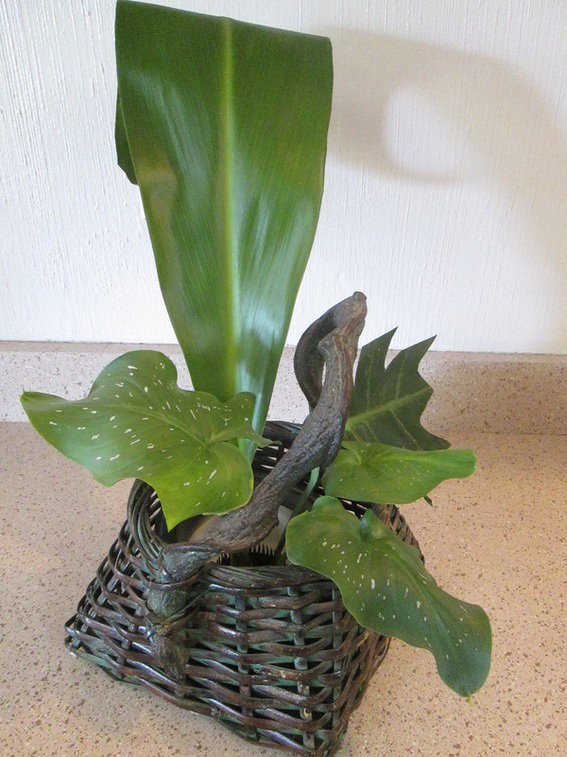
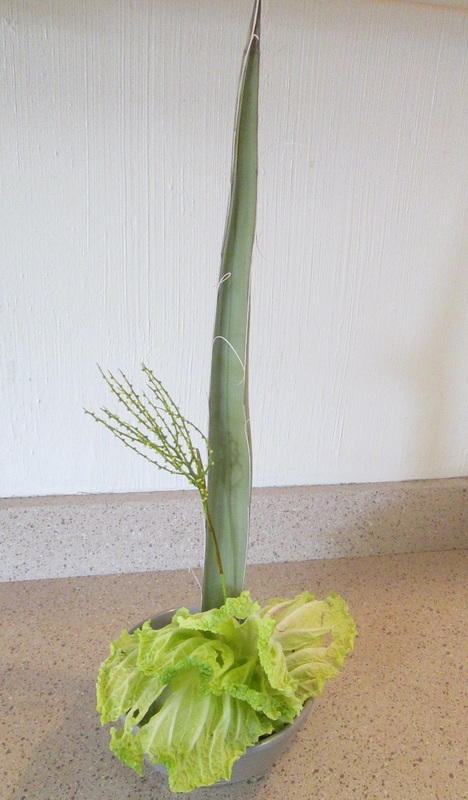
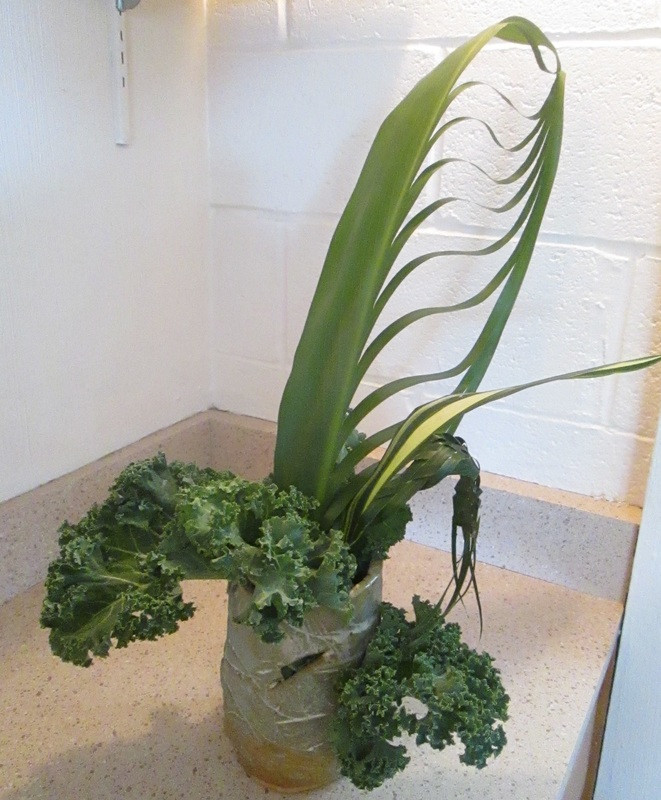
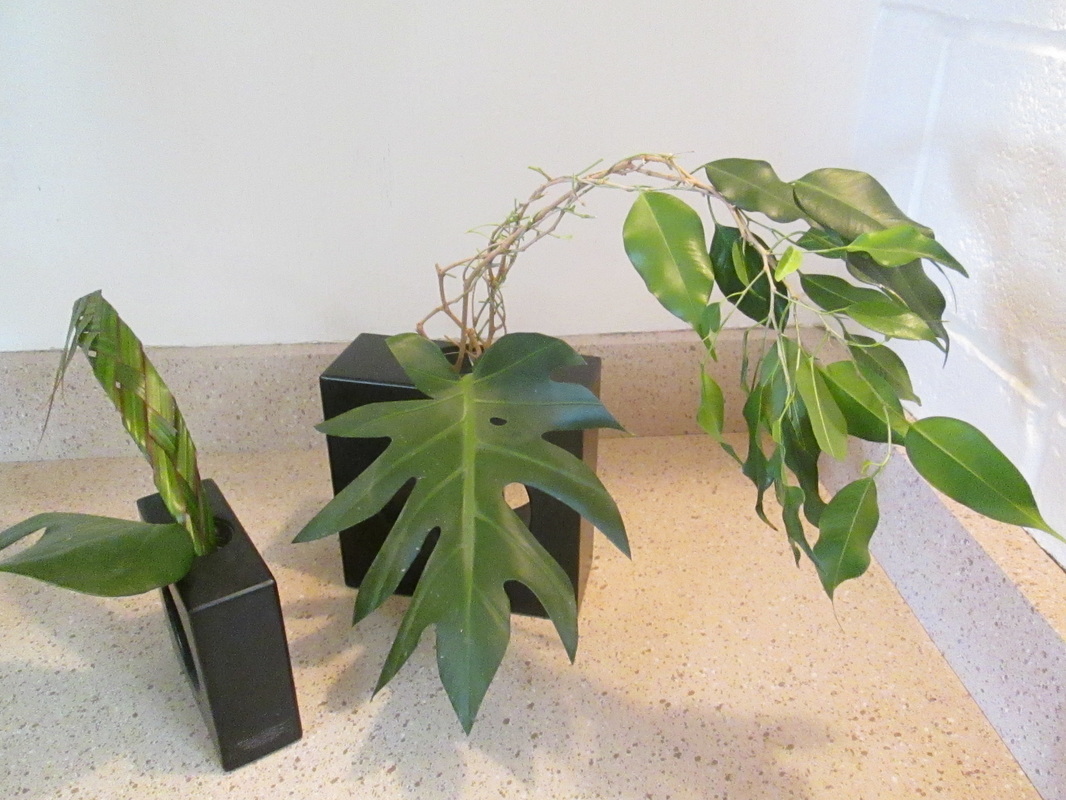

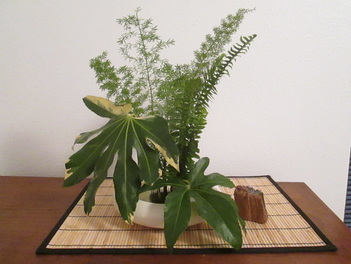
 RSS Feed
RSS Feed
